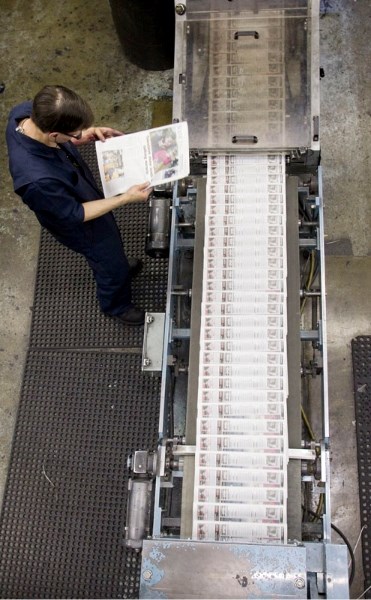It begins with a blank page. With every issue of the Gazette the various departments that work together to produce the newspaper twice each week start over, virtually from the beginning.
The reporters and editors in the newsroom receive dozens of news releases and hundreds of emails every week with story tips, ideas and suggestions. The ideas come from local, national and provincial organizations. They come from businesses, politicians and residents who have noticed something different, disturbing or new in their neighbourhood.
The reporters at the Gazette also find stories at the courthouse and city hall, in local schools and on sports fields and in countless other places in our community.
The flow of information into a newsroom is constant and the reporters and editors sort through it, find the most interesting and most important information and turn those into stories and photos for each issue.
Also working to fill those pages and pay our bills is the advertising department. Each week the dozen advertising representatives work with their clients to design ads that will bring them business and reach out to their customers.
The department works with approximately 1,500 clients booking roughly 400 advertisements per week.
It is in the production department that the paper is stitched together. The production department designs and creates many of the advertisements that appear in print, while others come to the paper ready to print.
In the day before each issue comes out, the production department becomes the hub of activity, blending the stories and photos from the newsroom with the advertisements on each page.
The production department creates the pages digitally, using layout software and then moves them along the process to the presses.
Before the paper starts spinning and the ink starts flowing, the digital pages must be printed onto aluminium plates. The plates are then baked to keep the impressions on and in the case of colour pages, they are done four times over.
The four colours, black, yellow, magenta and cyan, allow the Gazette to produce full colour photographs and advertisements, by layering the colours over top of each other.
When the aluminium plates are all printed, the edges of the plates are curled, allowing them to be bent around the cylinders and placed on the press.
When the massive presses start running, the cylinder holding the plate transfers the image to another cylinder, which then transfers it onto the newsprint in a process called offset printing.
When running at full speed, the presses can print some 20,000 copies every hour. After the image is applied, the paper is printed and folded and comes out the other end ready to be packaged.
The Gazette prints more pages and more colour than our current presses can handle, so the paper is printed in two sections. Once both sections have finished printing, they are inserted together by a team of part-time employees.
Those papers are then bundled specifically for each carrier route and sent out in trucks. The Wednesday edition of the Gazette is taken to local post offices as well, so it reaches our Sturgeon County readers.
In total, more than 26,000 copies are printed and distributed on Wednesday and 21,000 copies go out exclusively in St. Albert on Saturdays. Those papers go to dozens of newspaper boxes, to many local businesses and to roughly 200 carriers.
When the papers starting hitting local mailboxes the process starts all over again with new advertisements, new stories and new blank pages.




